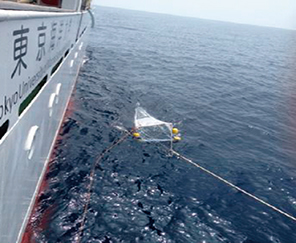Master Techniques from Japan to the World 3
Academia in Japan and Thailand Taking on the Challenge of Clarifying the Actual State of the Marine Plastic Wastes Problem
—Intellectual contribution to science-based policy making—

Collecting microplastics (Photo: Kyushu University)

A meeting between researchers from Japan and Thailand held online due to COVID-19 (Dr. Isobe is leftmost in the top row, and Dr. Viyakarn is rightmost in the middle row) (Photo: Kyushu University)
In recent years, global interest in marine pollution caused by plastic wastes has been rising.*1 Plastic has now become essential for our lives and supports the lives of many people in developing countries, including the vulnerable. For example, it enables us to transport drinking water to the regions without a water supply. However, plastic can have a serious impact on ecosystems if it is not processed appropriately after use and is released out into the natural world, so measures to deal with marine plastic wastes have become an urgent issue. Researchers on marine plastic pollution have been rapidly increasing globally since approximately 10 years ago, but large aspects of the problem remain unexplained scientifically, including its outflow routes and the impact on the marine environment.
In response to this situation, a research team led by Dr. ISOBE Atsuhiko, Professor of Kyushu University, and Dr. Voranop Viyakarn, Professor of Chulalongkorn University in Thailand, commenced the “Project for Formation of a Center of Excellence for Marine Plastic Pollution Studies in the Southeast Asian Seas” under the Science and Technology Research Partnership for Sustainable Development (SATREPS)*2 program. From its base at the Center of Excellence in Thailand, the team is conducting scientific surveys and analysis on the path of generation and amounts of plastic wastes, among other matters, in the Southeast Asian seas, a marine plastic pollution hotspot.*3
“In order to solve this problem, firstly we need to accurately ascertain the volume and the routes of the marine plastic wastes generated. Due to the impact of COVID-19, Japan’s researchers currently cannot travel overseas, so Thailand’s researchers are using new technologies such as drones to monitor the land, rivers, and oceans, and researchers in both countries are holding a series of discussions while checking the survey results online,” said Dr. Isobe.
Dr. Viyakarn, the representative of the Thai side, studied at a high school in Japan as a Royal Thai Government scholarship student and devoted himself to his studies in Japan for 13-and-a-half years until he earned his doctorate. “I would like the research technologies of Japan to be utilized, and the young researchers of Thailand and Japan to be trained though this project. One of the important objectives of this project is enhancing the capacity and developing human resources of research institutions,” said Dr. Viyakarn. In Thailand, the Center for Ocean Plastic Studies (COPS), a satellite research center of Kyushu University, was opened in Chulalongkorn University in April 2022.
“We have received support from the Japan Science and Technology Agency (JST), and already our partnerships with overseas research institutions in the surrounding countries are expanding. The problem of plastic wastes measures is not a simple matter of eliminating all plastics at once. In particular, it is necessary to advance its reduction initiatives with the consent of all people, while taking into consideration the impact on the lives of people in vulnerable positions. For that reason, consensus building based on scientific evidence is essential. We hope that this project will establish a center of excellence that reaches a global audience, and that Thailand will become a role model for plastic wastes reduction among developing countries,” said Dr. Isobe.
It is expected that the collaboration between the scientists of Japan and Thailand will spread across Southeast Asia and then to the entire world, including Japan, with the aim of solving the plastic wastes problem.
*1 See Part II 3 “(6) Actions on the Environment and Climate Change.”
*2 See the glossary.
*3 An area or region with a high concentration of pollutants.
<< Previous Page Next Page >>
Main Text | Reference Statistics | Stories from the Field | Master Techniques from Japan to the World | ODA Topics
